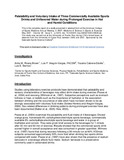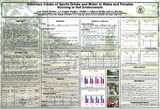Mostrar el registro sencillo del ítem
Palatability and Voluntary Intake of Three Commercially Available Sports Drinks and Unflavored Water during Prolonged Exercise in Hot and Humid Conditions
| dc.creator | Rivera Brown, Anita | |
| dc.creator | Aragón Vargas, Luis Fernando | |
| dc.creator | Cabrera Dávila, Yazaira | |
| dc.creator | Berríos, Luis E. | |
| dc.date.accessioned | 2014-08-19T22:49:41Z | |
| dc.date.available | 2014-08-19T22:49:41Z | |
| dc.date.issued | 2007-05 | |
| dc.identifier.citation | http://journals.lww.com/acsm-msse/Citation/2007/05001/Voluntary_Intake_of_Sports_Drinks_and_Water_in.2045.aspx | |
| dc.identifier.uri | https://hdl.handle.net/10669/11105 | |
| dc.description | pre-print, artículo (arbitrado) -- Universidad de Costa Rica. Centro de Investigación en Ciencias del Movimiento Humano (CIMOHU), 2007. Este es el reporte completo de dónde se extrajo el póster "Voluntary Intake of Sports Drinks and Water in Males and Females Running in Hot Environment: 1864: Board #152 May 31 8:00 AM 9:30 AM" | es_ES |
| dc.description.abstract | PURPOSE: This study compared the palatability and voluntary intake of beverages that have different sensory characteristics, between male and female athletes while running or racewalking in a tropical climate. METHODS: Thirty-six athletes (runners n=31; racewalkers n=5), 18 males (M;mean age=18.9 ± 3.5 yr) and 18 females (F;mean age=20.1± 4.7 yr), were recruited. Subjects completed four 90-minute sessions, running or race walking outdoors (mean distance M=18.0 ± 1.7; F=13.1 ± 2.0 km) at an intensity requiring 80 to 85% of age predicted maximum heart rate in a hot and humid environment (WBGT=30.1±1.1oC) on separate days. One of 4 commercial beverages was offered on each occasion: unflavored water (W), 6% carbohydrate-electrolyte solution (CES), 6% carbohydrate-electrolyte + preservatives solution (CESP1) or 8% carbohydrate-electrolyte + preservatives + B vitamins solution (CESP2). Beverage order was assigned in a Latin Square, double-blind design. They were served cold in squeeze bottles and subjects drank as desired. Palatability was measured during a one-minute exercise break at 15-minute intervals using visual analog 10-point scales and 9-point category scales. RESULTS: There were no differences between conditions (P > 0.05) in environmental variables, exercise intensity or sweat rates. The amounts consumed of the four beverages were similar and insufficient to match sweat rates (W = 17.0 ± 4.8; CES=16.9 ± 5.4; CESP1=17.8 ± 5.4; CESP2=17.5 ± 5.2 ml.kg-1, P>0.05). Males showed a higher fluid intake (18.5 ± 5.4 vs. 16.1 ± 4.7 ml.kg-1, P=0.006) but greater level of dehydration (2.6 ± 0.7 vs. 1.5 ± 0.8 % BM) in all conditions (P < 0.001). No differences were found between males and females in overall acceptance, liking of flavor or thirst quenching at any time point. CONCLUSIONS: Female athletes replaced more of their sweat losses than males but both groups finished dehydrated, with no differences among beverages. Contrary to a previous report in older individuals, females did not drink more water than males. The reluctance of young athletes to drink while running or racewalking in a hot and humid outdoor environment did not seem to be due to the palatability of these beverages and should be further investigated. | es_ES |
| dc.description.sponsorship | Sponsored by the Gatorade Sports Science Institute, Universidad de Costa Rica | es_ES |
| dc.language.iso | en_US | es_ES |
| dc.publisher | Medicine & Science in Sports & Exercise: 39(5), p S315 | es_ES |
| dc.rights | Atribución 4.0 Internacional | es_ES |
| dc.rights.uri | http://creativecommons.org/licenses/4.0/ | es_ES |
| dc.subject | Dehydration | en |
| dc.subject | Running | en |
| dc.subject | Hidratación | es_ES |
| dc.subject | Carrera | es_ES |
| dc.subject | Ejercicio | es_ES |
| dc.subject | Deshidratación | es_ES |
| dc.subject | Hydration | en |
| dc.subject | Exercise | en |
| dc.title | Palatability and Voluntary Intake of Three Commercially Available Sports Drinks and Unflavored Water during Prolonged Exercise in Hot and Humid Conditions | en |
| dc.type | informe científico | |
| dc.type | informe | |
| dc.identifier.doi | 10.1249/01.mss.0000274223.49529.eb | es_ES |
| dc.description.procedence | UCR::Vicerrectoría de Investigación::Unidades de Investigación::Ciencias Sociales::Centro de Investigación en Ciencias del Movimiento Humano (CIMOHU) | es_ES |
Ficheros en el ítem
Este ítem aparece en la(s) siguiente(s) colección(ones)
-
Tecnología en Alimentos [403]




